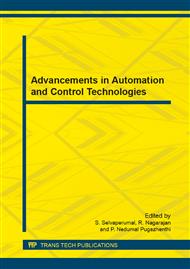[1]
Pilcher, June J., Huffcutt, Allen J., Effects of sleep deprivation on performance: A meta-analysis, Journal of Sleep Research & Sleep Medicine, Vol 19(4) (1996) 318-326.
DOI: 10.1093/sleep/19.4.318
Google Scholar
[2]
Hoang ChuDuc, Kien NguyenPhan, Dung NguyenViet, A Review of Heart Rate Variability and its Applications, APCBEE Procedia 7 (2013) 80 – 85.
DOI: 10.1016/j.apcbee.2013.08.016
Google Scholar
[3]
Information on http: /www. thehindu. com/sci-tech/health/policy-and-issues/goodnight-sleep-tight/article3276986. ece.
Google Scholar
[4]
A. Rechtschaffen and A. Kales, Eds, A Manual of Standardized Terminology, Techniques and Scoring System for Sleep Stage of Human Subjects, Washington, D.C.: Public Health Service U. S. Government Printing Office, (1968).
Google Scholar
[5]
Task Force Eur. Soc. Cardiol. and North Amer. Soc. Pacing and Electrophysiology, Heart rate variability - Standards of measurement, physiological interpretation and clinical use, Eur. Heart J., 17 (1996) 354–382.
DOI: 10.1111/j.1542-474x.1996.tb00275.x
Google Scholar
[6]
Saul JP, Albrecht P, Berger RD, Cohen RJ., Analysis of long-term heart rate variability: methods, 1/f scaling and implications, Computers in Cardiology, IEEE Computer Society Press, (1988) 419-422.
Google Scholar
[7]
Stefan Telser, Martin Staudacher, Bernhard Hennig, Yvonne Ploner, Anton Amann Hartmann Hinterhuber , Monika Ritsch-Marte, Temporally Resolved Fluctuation Analysis of Sleep ECG, J Biol Phys 33 (2007) 19-33.
DOI: 10.1007/s10867-007-9039-y
Google Scholar
[8]
Goldberger AL, Amaral LAN, Glass L, Hausdorff JM, Ivanov PCh, Mark RG, Mietus JE, Moody GB, Peng CK, Stanley HE. PhysioBank, PhysioToolkit, and PhysioNet: Components of a New Research Resource for Complex Physiologic Signals, Circulation 101(23) 215-220.
DOI: 10.1161/01.cir.101.23.e215
Google Scholar
[9]
Jan W. Kantelhardt, Yosef Ashkenazy, Plamen Ch. Ivanov, Armin Bunde, Shlomo Havlin, Thomas Penzel, Jörg-Hermann Peter, H. Eugene Stanley, Characterization of sleep stages by correlations in the magnitude and sign of heartbeat increments, Phys. Rev. E 65 (2002).
DOI: 10.1103/physreve.65.051908
Google Scholar
[10]
R. Bouckaert, Bayesian network classifiers in weka, Technical report, University of Waikato, (2008).
Google Scholar
[11]
Ary Noviyanto, Sani M. Isa, Ito Wasito, Aniati Murni Arymurthy, Selecting Features of Single Lead ECG Signal for Automatic Sleep Stages Classification using Correlation-based Feature Subset Selection, International Journal of Computer Science, 8(5) (2011).
Google Scholar
[12]
Aaron Lewicke, Edward Sazonov, , Michael J. Corwin, Michael Neuman, Stephanie Schuckers, and CHIME Study Group, Sleep Versus Wake Classification From Heart Rate Variability Using Computational Intelligence: Consideration of Rejection in Classification Models, IEEE Transactions on Biomedical Engineering 55 (2008).
DOI: 10.1109/tbme.2007.900558
Google Scholar
[13]
T. Kohonen, Self-organizing maps, in Springer Series in Information Sciences, Third Edition, Springer-Verlag, New York, (2001).
Google Scholar
[14]
Saibal Dutta, Amitava Chatterjee, Sugata Munshi, Identification of ECG beats from cross-spectrum information aided learning vector quantization, Measurement 44(10) (2011) 2020-(2027).
DOI: 10.1016/j.measurement.2011.08.014
Google Scholar
[15]
N. Cristianini, J. S. Taylor, An Introduction to Support Vector Machines And Other Kernel-Based Learning Methods. Cambridge U.K.: Cambridge Univ. Press (2000).
DOI: 10.1017/cbo9780511801389
Google Scholar
[16]
Lewicke, A.T. Sazonov, E. S. Corwin, M.J. Schuckers, S, Reliable determination of sleep versus wake from heart rate variability using neural networks, Proceedings of IEEE International Joint Conference on Neural Networks 4 (2005) 2394 -2399.
DOI: 10.1109/ijcnn.2005.1556277
Google Scholar
[17]
Guyon, I., Weston, J., Barnhill, S., Vapnick, V., Gene selection for cancer classification using support vector machines, Journal of Machine Learning, 46 (2002) 389 - 422.
Google Scholar
[18]
Bülent Yılmaz, Musa H Asyalı, Eren Arıkan, Sinan Yetkin, Fuat Ozgen, Sleep stage and obstructive apneaic epoch classification using single-lead ECG, BioMedical Engineering OnLine 9(1) (2010) 39.
DOI: 10.1186/1475-925x-9-39
Google Scholar
[19]
C. S. Yoo, S. H. Yi, Effects of Detrending for Analysis of Heart Rate Variability and Applications to the Estimation of Depth of Anesthesia, Journal of the Korean Physical Society 44(3) (2004) 561-568.
DOI: 10.3938/jkps.44.561
Google Scholar
[20]
Mourad Adnane, Zhongwei Jian, Zhonghong Yan, Sleep. wake stages classification and sleep efficiency estimation using single-lead electrocardiogram, Expert Systems with Applications, Elsivier 39 (2012) 1401–1413.
DOI: 10.1016/j.eswa.2011.08.022
Google Scholar
[21]
Stefan Telser , Martin Staudacher , Yvonne Ploner , Anton Amann, Hartmann Hinterhuber, Monika Ritsch-Marte, Can One Detect Sleep Stage Transitions for On-Line Sleep Scoring by Monitoring the Heart Rate Variability? Journal of Somnologie, 8 (2004).
DOI: 10.1111/j.1439-054x.2004.00016.x
Google Scholar
[22]
Julius Sim, Chris C Wright, The Kappa Statistic in Reliability Studies: Use, Interpretation, and Sample Size Requirements, Physical Therapy, 85(3) (2005) 257-268.
DOI: 10.1093/ptj/85.3.257
Google Scholar


